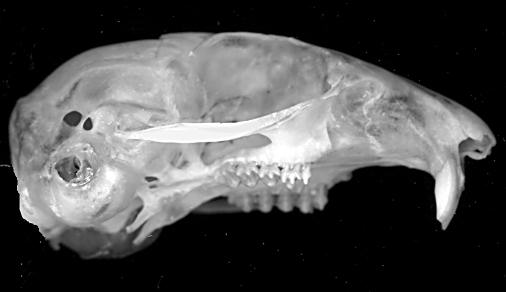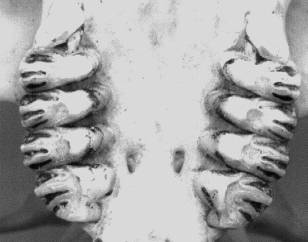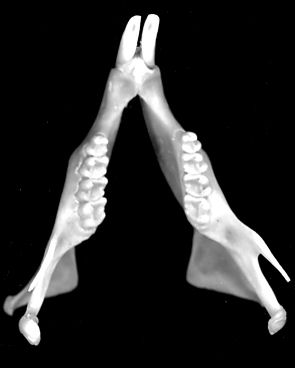Unlike the limited diversity and geographic distribution of the Aplodontidae, the Sciuridae is diverse and widely distributed. There are something like 51 genera and some 273 species found nearly worldwide. Representatives include such familiar animals as chipmunks, tree squirrels, flying squirrels, ground squirrels, marmots (woodchucks) and prairie dogs.
 A skull that usually is arched has a flattened or slightly concave area at the front of the
zygomatic arch: the zygomatic plate. This is where the anterior part of the masseter lateralis inserts. There usually is a well marked tubercle anterior to the upper toothrow where the masseter
surficialis inserts. The tooth formula is 1/1 0/0 1-2/1 3/3 = 20 - 22. All teeth are rooted. Molars generally have at least some transverse lophs. Limbs are primitive in that the feet are
pentadactyl, the tibia and fibula are unfused, and wrist and ankle allow free movement.
A skull that usually is arched has a flattened or slightly concave area at the front of the
zygomatic arch: the zygomatic plate. This is where the anterior part of the masseter lateralis inserts. There usually is a well marked tubercle anterior to the upper toothrow where the masseter
surficialis inserts. The tooth formula is 1/1 0/0 1-2/1 3/3 = 20 - 22. All teeth are rooted. Molars generally have at least some transverse lophs. Limbs are primitive in that the feet are
pentadactyl, the tibia and fibula are unfused, and wrist and ankle allow free movement. 
Fig. 1 (right). Lateral view of a typical sciurid skull.
Fig. 2 (left). Palatal view of Gunnison's Prairie Dog (Cynomys gunnisoni) shows the typical "bear paw" cheek teeth of sciurids. Differences among taxa include completeness of lophs and how they join. Other differences are in robustness and degree of hypsodonty.
 When present, P3 often is simpler than the last premolar and may be little more
than a peg, as seen (poorly) here. The strong posterior convergence of the cheek tooth rows is one of the characters that will separate prairie dogs from other sciurids in our region.
When present, P3 often is simpler than the last premolar and may be little more
than a peg, as seen (poorly) here. The strong posterior convergence of the cheek tooth rows is one of the characters that will separate prairie dogs from other sciurids in our region.
Fig. 3. Lower jaw and dentition typical of sciurids.
Many sciurids in cold regions hibernate; the tree squirrels, however, do not, even in areas where winters are extremely cold. Some ground squirrels in arid regions apparently estivate.
Various groups of squirrels have specialized in different directions. The tree and flying squirrels are arboreal; here, sharp claws and the freely mobile ankles (allowing the feet to point toward the back when descending) hold the animals in good stead. The flying squirrels, of course, do not fly, but are excellent gliders. A membrane (the patagium) stretches between the wrist and ankle areas, and the flattened tail allows maneuverability. Gliding allow movement from tree to tree without having to cross open areas on the ground where vulnerability to predators is greatly increased.
Sciurids within North America can conveniently be grouped into tree squirrels (Sciurus, Tamiasciurus), marmots (Marmota), ground squirrels (Ictidiomys, Otospermophilus, Xerospermophilus ), antelope squirrels (Ammospermophilus), prairie dogs (Cynomys), chipmunks (Tamias), and flying squirrels (Glaucomys). All but flying squirrels have representatives within the Greater El Paso Region.
Information on several of these can be found on the Sevilleta web site (under the older names given here), including on the Cliff Chipmunk (Tamias dorsalis), White-tailed Antelope Squirrel (Ammospermophilus leucurus), Texas Antelope Squirrel (Ammospermophilus interpres), Spotted Ground Squirrel (Spermophilus spilosoma), Rock Squirrel (Spermophilus variegatus), and Gunnison's Prairie Dog (Cynomys gunnisoni).
Tree squirrels in the region include Abert's Squirrel (Sciurus aberti), rather closely limited to Ponderosa Pine (Pinus ponderosa) and thus to montane areas in our region. Interestingly, it historically was limited to highlands west of the Rio Grande. The squirrel apparently was introduced into the Sandia Mountains (west of Albuquerque) and then dispersed naturally to the Manzano Mountains, south of the Sandias and separated from the Sandias by pinyon-juniper woodland.
In New Mexico, the Arizona Gray Squirrel (S. arizonensis) is limited to the riparian forest of the San Francisco River drainage in Catron County. Although there is a queried record by Slaughter (1975) of a late Wisconsin occurrence at Blackwater Draw (between Clovis and Portales, near the Texas border in east-central New Mexico), this is biogeographically unlikely. Slaughter apparently did not consider the possibility of the Gray Squirrel (S. carolinensis), which occurs in that drainage, though far to the east in central Texas.
The Fox Squirrel (S. niger) has been introduced into the Roswell area of New Mexico and quite possibly elsewhere in New Mexico and Trans-Pecos Texas. A relative, the Mexican Fox Squirrel (S. nayaritensis), occurs in the Chiricahua Mountains of southeastern Arizona, occupying open Apache Pine/oak forest (Hoffmeister 1986).
The last tree squirrel in our area is the Red Squirrel (Tamiasciurus hudsonicus). This is a basically boreal animal that extends far to the south of its main range in the highlands of the Rocky and Appalachian mountains. A closely related species (T. douglasii) replaces the Red Squirrel in montane areas from southwestern British Columbia well south in the Sierra Nevada of California. In our area, T. hudsonicus is a high-elevation animal associated closely with spruce-fir forest and, in fact, is absent from ranges that do not support reasonable amounts of such vegetation. Farther north, the animal is less limited. These squirrel feed extensively on seeds of a few kinds of conifers (spruce, Douglas Fir, White Fir) and construct large middens beneath some trees. These middens, mostly of scales of cones and cone cores and, buried within the middens, cones themselves, may exceed 15 feet in diameter and be a foot or more deep. The stored cones supply seeds for food during the winter and spring. Fungi, plant buds, and fruit also are eaten.
The Mount Graham Red Squirrel has been a source of considerable controversy in recent years. Habitat is extremely limited and the University of Arizona has attempted to build an observatory within the habitat. This Red Squirrel is appears to have been isolated longer than most populations in the Southwest and is named as an endemic subspecies (T. h. grahamensis), thus leading to attempts to preserve its habitat.
The genus Marmota includes large rodents generally known as marmots in the West and woodchucks in the East. The regional species is Marmota flaviventris, the Yellow-bellied Marmot. Although now limited to the far northern reaches of our region, in the high mountains of northern New Mexico and in lower elevations of the San Juan Basin in northwestern New Mexico, they were widespread in the Pleistocene. Fossil records are common in the highland regions of southern New Mexico. Harris (1970) hypothesized that the Yellow-bellied Marmot required sufficient winter precipitation to support green fodder through the spring drought characteristic of the eastern Southwest. Marmots emerging from hibernation would require such foods to be available immediately. Such fodder is unavailable in the lowlands with the current level of winter precipitation in the southern portions of our region coupled with the severe spring drought, and only a single season in the southern highland areas would be sufficient to wipe out southern marmot populations.
Last Update: 10 Aug 2009
Centennial Museum and Department of Biological Sciences, The University of Texas at El Paso